Sustained growth is something that all companies look forward to. But it has been challenging to get it in recent years. Business growth slowed dramatically after the 2008 financial crisis, and now, with the global economy slowing, geopolitical instability, and rising inflation, growth has become an even more significant challenge. Few companies can boast of achieving continuous growth in recent decades, and even fewer of achieving growth above 10%.
To counter these trends, business leaders must follow a holistic growth plan to benefit from competitive advantages, focus on profitable and fast-growing markets, select disruptive initiatives, expand their core and adjacent businesses, and look for opportunities by building new businesses or mergers and acquisitions.
Hoshin is the approach companies need to empower leaders to make the right choices at the right time and drive short and long-term growth.
The Basics of Hoshin Planning and Deployment
The term Hoshin Kanri comes from the Japanese words “hoshin”, which means “direction” or “compass needle”, and Kanri, which means “management” or “control”.
This methodology creates alignment, ensuring the whole company focuses on what is important, the significant few breakthroughs. This method is applied to align individual goals and resources throughout the organization so that everyone knows their responsibilities regarding the organization’s improvement priorities. The process starts with the strategy definition and ends by clearly describing the needed changes at the point of impact. By recognizing the root causes and implementing solutions, it is possible to deliver real improvement at this point.
The central Hoshin Planning and Deployment goals are:
- Align and focus the management team on implementing and achieving strategic results.
- Define value drivers with breakthrough and consensual impact on the business unit’s EVA (Economic Value-Added).
- Deploy strategic priorities to action plans at the point of impact.
- Create a monthly follow-up and a problem-solving culture.
- Perform Hansei (the Japanese word for reflection, meaning to acknowledge one’s mistake and pledge improvement) on the effectiveness of breakthrough priorities.
In brief, it is the process of defining and achieving sustainable growth goals through excellence in innovation, commercial, and operations with a continuous improvement culture and excellent results.
The Benefits of Hoshin Kanri: Solving Strategic Planning Problems
Strategic planning and deployment can be complex and challenging, and there are several problems that organizations may face in this process. Here are some of the most common issues:
- Lack of commitment and engagement of the leadership team,
- Lack of objectivity and significant perspective,
- Making the process too complex,
- Do not start on time or follow a schedule,
- Not putting enough emphasis on the environment and external capacities,
- Excessive concentration on threats and weaknesses,
- Dogmatic use of models and processes,
- Allow reducing the strategic plan to budgeting and forecasting,
- Poorly thought-out action plans and problem-solving initiatives,
- Underestimate needs and resources available,
- Building strategic planning at a different business pace,
- Incorrect assumptions or incomplete data,
- Failure to track progress at the right pace and frequency,
- Lack of communication and accountability.
Hoshin Planning and Deployment enhances the communication of the strategic objectives, ensures the alignment and prioritization of what is most critical to executing with all levels involved, and emphasizes achieving results. It seeks to help leaders to make their dreams come true.
When done effectively, strategic planning can bring numerous benefits to an organization. Here are some of the key benefits of strategic planning:
- Provide clarity, focus, and alignment to achieve breakthrough results,
- Define an effective growth plan for the business,
- Allow a deployment with consensus and communication,
- Promote effective resource allocation,
- Increase sales, profits, and market value,
- Enable continuous improvement year after year.
In summary, hoshin planning and deployment is a visual, participatory, fast, and effective process that generates highly profitable and sustained growth. It is far more effective and less costly than traditional strategic planning.
Other Strategy Planning Tools and Techniques
Strategic planning is a common and fundamental challenge for the world’s largest companies. Before getting into the hoshin planning and deployment process, let’s address different Strategy Planning tools companies use worldwide.
There are several strategic planning tools that organizations can use to develop and implement their strategic plans. Here are some commonly used tools, starting from the least structured to the most structured:
- Management By Objectives (MBO),
- 4 Disciplines of Execution (4DX),
- Balanced Scorecards,
- Objectives, Goals, Strategies, Measures (OGSM),
- Objectives and Key Results (OKRs),
Management By Objectives (MBO)
Management by Objectives (MBO) is a management technique that involves setting specific and measurable objectives for employees to achieve and then regularly reviewing their progress toward those objectives. The key features of MBO include determining organizational goals, determining employees’ objectives, constantly monitoring progress and performance, performance evaluation, providing feedback, and MBO performance appraisal.
4DX (4 Disciplines of Execution)
The 4 Disciplines of Execution (4DX) is a performance management framework designed to help organizations achieve their most important goals by focusing on a few critical priorities and executing them excellently. The four disciplines are: focus on the wildly important goal (wig), act on lead measures, keep a compelling scoreboard, and create a cadence of accountability.
Balanced Scorecards
Balanced Scorecards are a strategic performance management tool that tracks and measures an organization’s progress toward achieving its goals and objectives. The balanced scorecard approach emphasizes a holistic view of the organization’s performance, considering financial and non-financial measures such as customer satisfaction, internal business processes, and employee satisfaction and development. The balanced scorecard typically includes four categories: financial, customer, internal processes, and learning and growth. Each category contains key performance indicators to measure progress toward the organization’s goals.
Objectives, Goals, Strategies, Measures
OGSM is a framework to set objectives, goals, strategies, and measures for business or organizational success. It is a way to align the organization’s activities towards a common set of goals and track progress toward them. Here is a brief overview of each component of OGSM: Objectives (broad, long-term outcomes that an organization wants to achieve and should align with the organization’s mission and vision), Goals (more specific and short-term than objectives, designed to support the achievement of the overall objectives), Strategies (plans or methods used to achieve the goals and should be realistic and achievable given the resources available to the organization) and Measures (tools used to track progress towards achieving the goals and should be designed to be specific, measurable, achievable, relevant, and time-bound).
Objectives and Key Results
OKRs is a goal-setting framework businesses and organizations use to establish and track progress towards objectives. The framework goal is to help teams and individuals focus on achieving specific, measurable, and ambitious goals. The basic idea behind OKRs is to establish a clear and specific objective and then identify key results that will indicate progress toward that objective. Key results are measurable outcomes that can be tracked and evaluated over time. The goals and key results should have regular intervals, and progress should be tracked and evaluated.
Although widely applied, all these tools have some gaps that could make it challenging to succeed in defining and deploying the organization’s strategy. The Hoshin Planning and Deployment approach is more structured and effective, allowing organizations to achieve results faster and more consistently.
Leaders are increasingly selective and careful in choosing the tools to define and deploy strategy. Companies have realized that good management depends on using the right tools in the right places, in the right ways, and at the correct times.
How to Implement Hoshin Planning and Deployment Successfully
Hoshin Planning and Deployment basis itself on five strategic macro factors for finding the strategic initiatives:
- Market Presence: Conquer Market Space,
- Change Drivers: Response to disruption,
- Value Innovation: Customer Centricity,
- Operational Excellence: Eliminate waste and Create flow,
- Continuous Improvement Culture: Develop people and leadership.
A winning strategy must explore growth in customer value, supplier value, and a continuous improvement culture with effective processes.
Within growth in customer value, it is necessary to visualize and focus on markets and segments, perform a customer value analysis, and implement value innovation for the customer with KAIZEN™ Events.
Within growth in supplier value, it is necessary to visualize and focus on value streams, perform a value stream analysis, and execute a value stream innovation.
Developing a culture of continuous improvement is done through implementing processes like daily management, KAIZEN™ events, and breakthrough priorities.
The Hoshin Planning process typically involves the following steps:
- Strategy Review
- Hoshin Deployment
- Breakthrough Priorities
- Hoshin Review
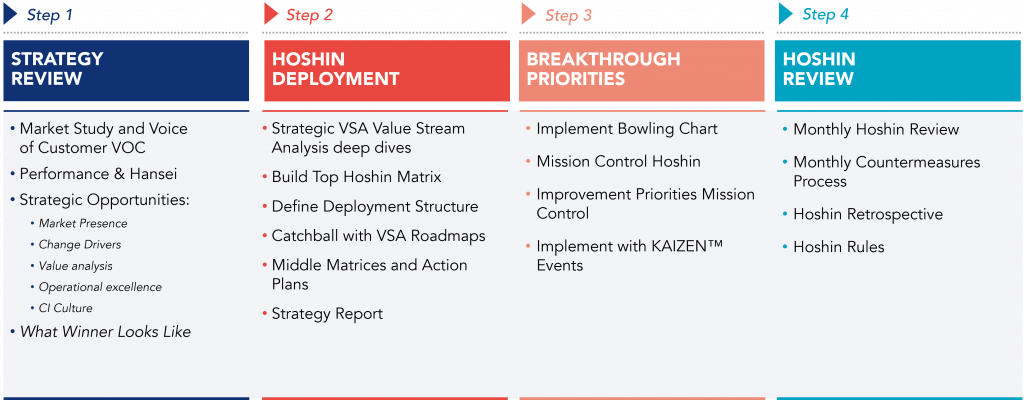
Strategy Review
It is necessary to ensure agreement between decision-makers when defining the strategic direction and priorities of the organization. The first step of Hoshin Planning is to agree on the significant Breakthrough objectives, which can turn into improvement priorities, directly linking the strategy to the point of impact, where the real action happens.
Data Collection and Preparation: The approach begins with collecting data about the company and its processes. The primary data to be collected are:
- Company organization and culture,
- Economic and financial data,
- Current strategy documents,
- Market study (data and market maps),
- Industry game rules,
- Voice of customer study,
- Operational efficiency data.
Refection about Performance & Hansei
Reflection should focus on observing sales and history results, analyzing tendencies, and understanding root causes. There is a need to set the ambition for the next 3 to 5 years (breakthroughs and outcomes) and the annual breakthrough priorities of the current strategy. It is necessary to check the effectiveness of the ongoing strategic plan implementation and agree on improvements for the following year.
Strategic Opportunities
This stage comprises the analysis of the organization’s strategic opportunities. The research involves observing the data collected during the preparation phase and discussing the opportunities. The primary analyses carried out in this phase are:
- Market presence (market presence/ share analysis with Mekko charts).
- Change drivers (external drivers, possible strategic implications, and significant changes in the last 12 months).
- Customers (Voice of Customer study).
- Operational Excellence (KAIZEN™ OPEX quick audit).
- Continuous Improvement Culture and Governance (KAIZEN™ change management and governance audits).
What a Winner Looks Like
It is an exercise that defines 3 to 5 years of strategic initiatives, options, and objectives. The exercise shall include the following steps:
- Identify main opportunities and strategic topics,
- Define what a winner looks like (list 5 to 8 winner capabilities),
- Identify gaps,
- Determine strategic initiatives (name initiative and list skills to develop),
- List quantitative goal (monetized),
- Create options for the initiatives, define initiatives portfolio, and validate ambition.
Hoshin Deployment
Strategic Value Streams Analysis (VSA)
Deep dives with Value Stream Analysis. VSA is a KAIZEN™ Event, a business analysis methodology that examines the flow of information, materials, and activities required to produce a product or service to identify improvement areas. Value Stream Mapping aims to identify and eliminate waste and inefficiencies in a company’s value streams, thereby improving overall productivity and profitability.
Build Top Hoshin Matrix
X-Matrix is the tool that allows putting the strategy of an organization on one single page. It will enable to breakdown company’s Strategy into Strategic Objectives in a visual format and, in a second phase, it also serves as input for deploying the strategy at lower levels of the organization. The top Hoshin Matrix describes the top-level objectives of the organization.
The construction of the Matrix entails the answer to 5 key questions:
- What do you want to achieve in 3 to 5 years? (Decide 3-5 years Strategic Initiatives Objectives)
- How far do you want to go in the first year? (Determine Annual Breakthrough Goals)
- How are you going to do it? (Identify Breakthrough Priorities)
- How will you measure success? (Determine Targets to Improve)
- Who is responsible? (Identify Resources)
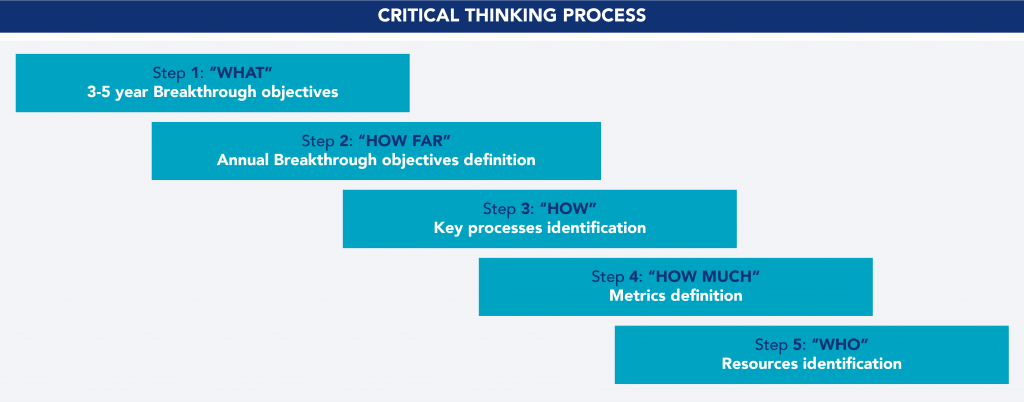
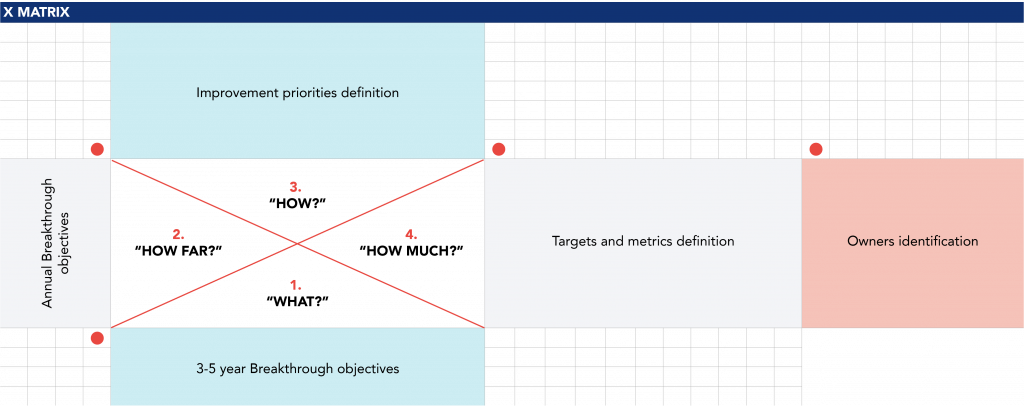
Define Deployment Structure and use Catchball with VSA Roadmaps, Middle Matrices, and Action Plans
Strategy deployment requires a balance between expectations, resources, and deadlines at the various relevant levels of the organization. The Catchball process is a collaborative process used in strategy deployment, which involves the exchange of feedback between different levels of an organization to achieve a common goal. The breakthrough priorities of a higher level are deployed to the lower-level Matrix or an action plan. The point of impact is where the action plan tackles root causes. It can be necessary to create 2nd and 3rd-level matrices. Create an action plan for each breakthrough priority and each owner.
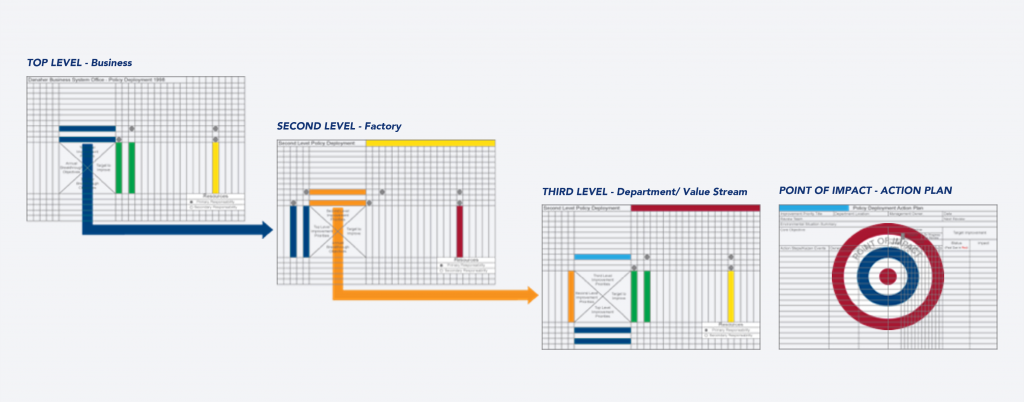
The Matrix is useless if it does not trigger any action. Therefore, each improvement priority should generate an action plan, materialized in KAIZEN™ Events, acting directly at the point of impact. The future state mapping defines the KAIZEN™ Events, each having to implement a part of the Future Vision. Follow these steps to build the action plan:
- Discussion of which KAIZEN™ Events are required and the scope of each one of them,
- KAIZEN™ Events prioritization, so event must occur in sequence with others,
- Identification of resources involved in each event,
- KAIZEN™ Events agenda to avoid resources overlap.
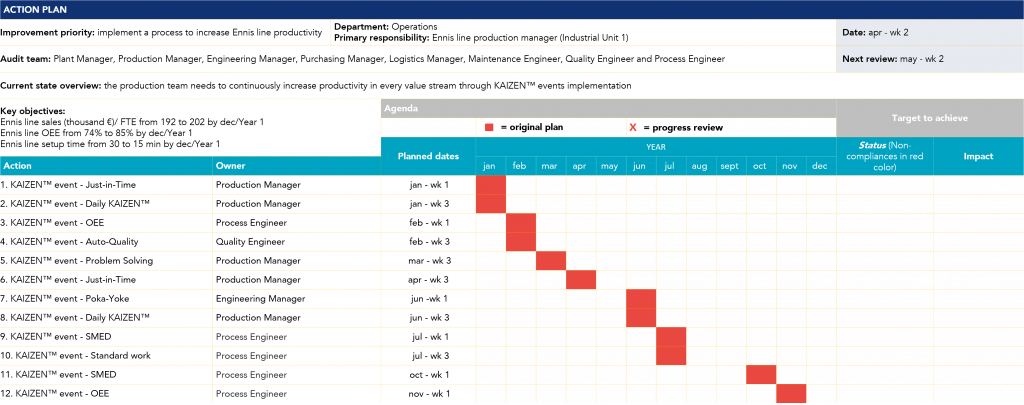
Breakthrough Priorities
Implement with Bowling Charts
List the improvement Priority and its Targets To Improve (TTI) in the Bowling chart and the quantification of the respective Hoshin objectives for each month. A Bowling Chart is a visual tool to monitor KPIs, comparing the organization’s actual metrics to the goals and targets the organization has set. The Bowler allows a quick analysis of results and reduces the time spent with emails, reports, and meetings. The results are either green or red, depending on a positive or negative outcome. This tool is an essential element of monthly reviews.
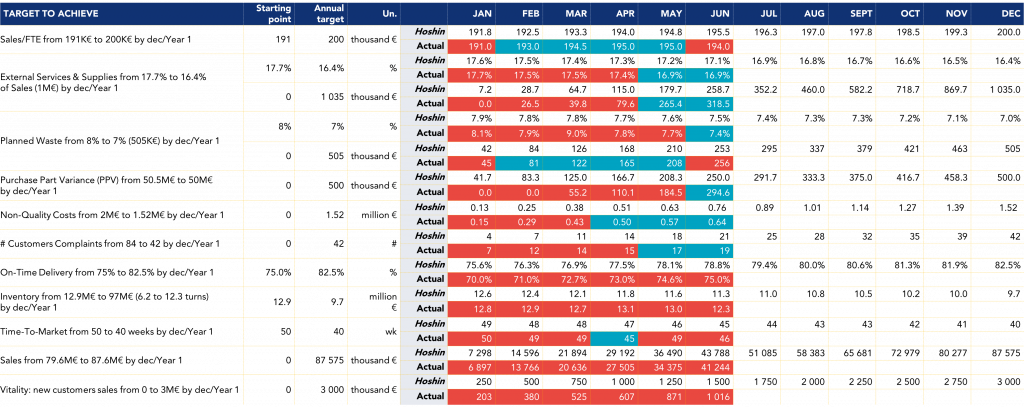
Establish Hoshin Mission Control
Develop a Mission Control Room (MCR) to perform Hoshin meetings. Follow-up of the action plan for each improvement priority at the point of impact. Follow up the bowling chart for each Matrix. In the same space, the MCR gathers all necessary information to follow up on the Hoshin progress regularly. Since most people collect 80% of their information through their eyes, the MCR applies the principle of visual management as a way of gathering data and displaying the results achieved to the targets to improve. The MCR has two essential functions: the Hoshin monthly review and the weekly local management review of improvement priorities of the KAIZEN™ Breakthroughs.

Implement with KAIZEN™ Events
Focused on the organization’s need for improvement, a KAIZEN™ Event is an intensive workshop divided into 3 phases:
- Preparation – data collection and provision of the equipment needed,
- Implementation – solution design and testing,
- Follow-up – monitoring the results and correcting failures.
A KAIZEN™ Event necessarily delivers results because it implements a new and better working method in the shortest amount of time. These are the golden rules of a KAIZEN™ Event:
- Multidisciplinary teamwork,
- Alignment and focus on a single theme,
- Quantified objectives,
- Well-defined duration (intensive days),
- GEMBA activities,
- Standard KAIZEN™ Lean tool or methodology,
- Results follow-up and financial impact calculation.
The KAIZEN™ Event leads the teams to focus on what they must do to carry out the Action Plan as quickly as possible. When leaders participate in any KAIZEN™ Event and realize that it is genuinely possible to implement changes so fast, it becomes the only way to improve the organization and deliver effective results.
Hoshin Review
Monthly Hoshin Review and Countermeasures Process
Throughout the implementation, periodic reviews to correct deviations evaluate the current performance against the partial objectives.
The reality is that companies will only sometimes hit the targets exactly, and we will fall short. Without a countermeasure, the company will continue to miss the mark, and the process will collapse. The real power of hoshin is the strength of the organization to correct quickly and reverse trends and its ability to apply countermeasures to negative situations or events.
The Hoshin planning process determines the breakthroughs, but the goal depends on the company’s ability to keep moving towards targets by constantly defining countermeasures for the effect of external and internal events.
All Countermeasures should be a structured automatic response. The rule is: a countermeasure should be adopted when a target to improve in the Bowler chart is red (below the monthly objective), and it is necessary to take corrective actions to bring the KPIs back into the green. No permission is required to elaborate on it, as it is the responsibility of the improvement priority responsible for presenting the countermeasure at Hoshin’s monthly review meeting. Deploying this behavior by the organization and enabling everyone to be part of the solution will create a culture of countermeasures.
Hoshin Retrospective
The Hoshin Retrospective’s primary goal is to improve the Hoshin Process and decide how to act to improve goals. It is necessary to check all objectives and targets to improve. Companies should run an annual assessment of the Hoshin Process with questions like:
- Did we do Hoshin effectively?
- Were the resources applied effectively?
- Were the Hoshin matrices implemented at the indicated level?
- Did we take strategy to the Point of Impact?
- Did we use the KAIZEN™ Continuous Improvement System Tools appropriately?
- Have we implemented sustainable processes, or did we get short-term results?
- Have our monthly reviews been effective, or should we change their structure?
- Did we just “dust” the Matrix at the end of the year, or do we monitor it month by month?
Reflect on the difficulties in implementing Hoshin and the lessons learned that follow. It was time to acknowledge further improvements and define the countermeasures to overcome them.
The importance of Leadership in Hoshin Planning and Deployment Process
Usually, organizations do not lack new ideas but do lack focus. In an attempt to implement all the initiatives considered, there is a loss of capacity in the execution, monitoring, and obtaining sustained results. Hoshin Planning and Deployment methodology play a crucial role in organizations, focusing decision makers on the most critical processes, those with real impact on results and customer value creation.
The permanent improvement requires a motivated team aligned with the organization’s purposes. It is crucial to have a leadership culture through example. “Leading by example” makes leaders fundamental to the change process, due to their active participation in improvement initiatives, alongside their teams. By committing to genuinely disruptive objectives, organizational leaders create the conditions to break current paradigms, challenging their people to set different limits and meet their new paradigms.
Hoshin Planning and Deployment approach transforms strategy into action, challenging and preparing organizations for the future through systematic management and focusing on process improvement, commitment from leaders, and everyone’s engagement.
Still have some questions about Hoshin Planning and Deployment
What is an x-matrix?
An X-Matrix is a visual tool used in the Hoshin Kanri methodology to capture and communicate strategic objectives and the means to achieve them. The Matrix allows for a comprehensive view of the organization’s strategic goals, the tactics to reach these goals, the metrics to measure progress, and the individuals responsible for achieving these objectives.
What is a Bowling Chart?
A Bowling Chart is another visual tool used in the Hoshin Kanri methodology to monitor Key Performance Indicators (KPIs) and compare the organization’s metrics to its goals and targets. It is an essential component of monthly reviews, providing a clear and immediate overview of the organization’s performance against its objectives and reducing time spent on emails, reports, and meetings.
What is the Catchball process?
The Hoshin Kanri Catchball is a process that fosters communication and agreement across all levels of the organization. This process cascades strategic goals and objectives down from top management to the operational levels, and feedback is gathered and sent back up the hierarchy, much like a ball passed back and forth – hence the term ‘catchball’.
See more on Strategy Deployment
Find out more about improving your organization
See more on People & Culture
Find out more about improving your organization
